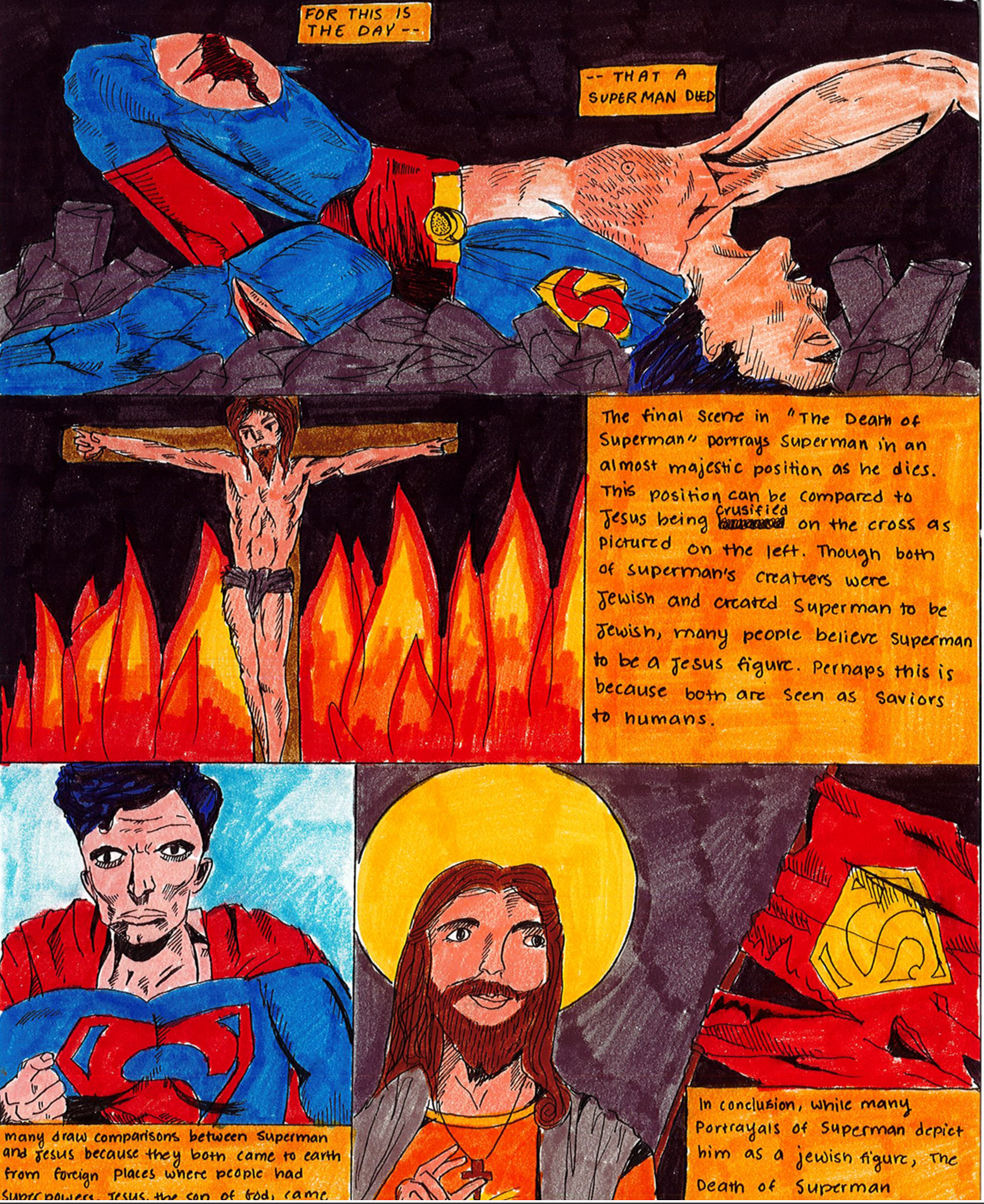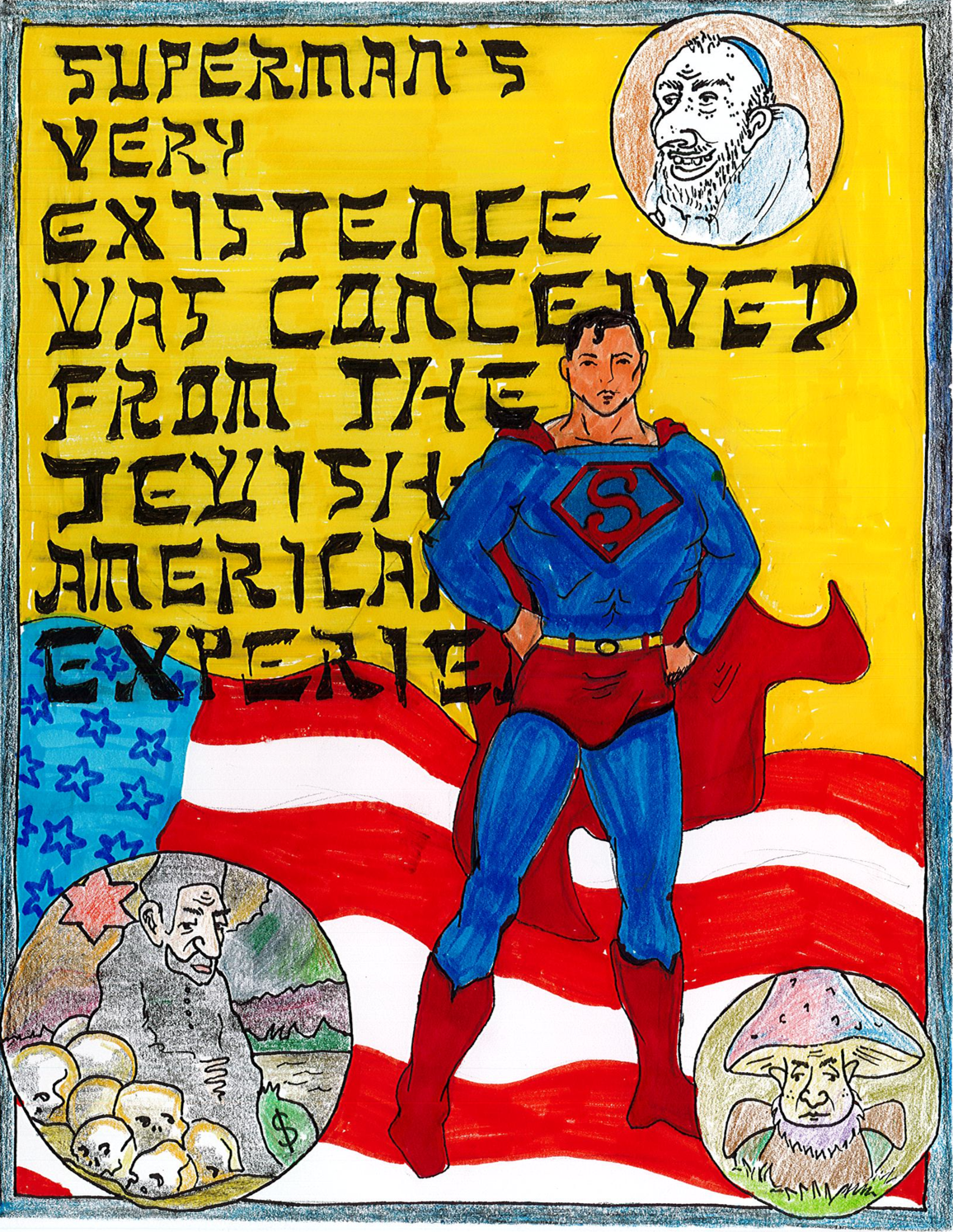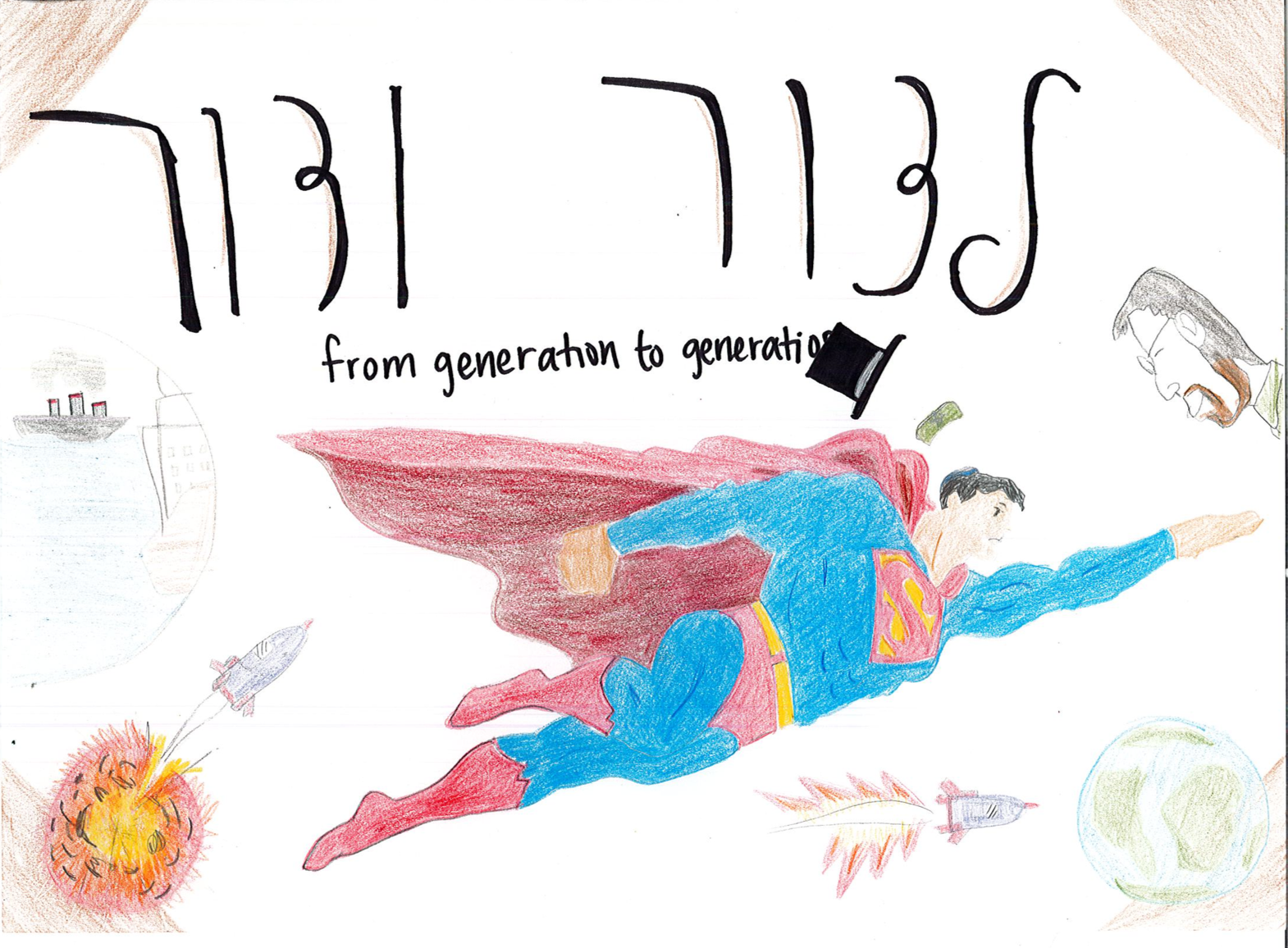Superman and Religion
Students in David Cutler's Popular Culture in American History share their creative take on how the original superhero represents more than just another comic book character.

Students in David Cutler's new Popular Culture in American History spent several weeks studying the Jewish origins of Superman's creation, as well as Jewish mysticism and emigration before, during, and after World War II. From there, the class researched how throughout the decades, Superman transformed into an even more powerful being, representing the ideals of many religions, not just Judaism. Recently, students finished "The Death of Superman," the 1993 bestselling graphic novel, before deciding how to creatively display how and why the Man of Steel represents various faiths.
To tackle this question, most students decided to draw comic book panels. You will also find a portion of their artist statements, which explain the inspiration for the artwork.
My comic book spread includes my artist statement, which describes Superman as a Chirst-like figure when he sacrafices himself at the end of Death of Superman. At the same time, I also point out that Superman symbolizes many religions, including Judaism. — Dessie Bell-Kamen
For my splash page, I juxtaposed anti-semitic caricatures of Jews with Superman’s iconic stance of heroism. I wanted to create contrast between the perceived stereotypes of Jewish men and the venerated, savior prototype that Jewish men, themselves, created. In doing so, I intended to draw attention to the duality of Jewish-American identity. In terms of palette choice, I used earthier colors to portray the stereotypes in the bubbles, and bright colors to depict Superman and the accompanying American flag, to further emphasize this contrast. I also included text. Mimicking a Hebrew font, I wrote, "Superman’s Very Existence Was Conceived From the Jewish-American Experience." — Chlöe Berlin.
For generations, Superman has represented a savior. Passed down since the original Action Comics #1 in 1938, Superman has graced books and movie screens, radios and newspapers alike, providing hope for the masses. While this is a common trope in pop culture, it traces back much further to times of political turmoil. My splash page features a Hebrew phrase, “from generation to generation,” common in many Jewish texts. Within this context, I likened Superman to religious figures like Moses, Jesus, as well as secular entities. I have pictured a space ship leaving Krypton and arriving at Earth, something that scholars, like Harry Brod, have compared to the Jewish immigrant experience. — Ella Meranus.
To show how Superman embodies Jesus Christ, especially in DC's Death of Superman, I drew a crown of thorns on Supermans’s head, with a cross on his cross. Though Superman is suffering, like Christ, he is also doing so willingly to help humanity. Doomsday, the monster who kills Superman, clearly represents the Devil—a being who cannot be defeated, only momentarily stopped, which mimics the fight between good and evil in real life. — Stephen Moreno Jimenez.
The last spread of DC's Death of Superman shows Superman dying in Lois Lanes' arms. This inspired my illustration, which shows how the Man of Steel, in defeating Doomsday, also sacrifices his life to save humanity. Superman has no face, showing how, even though he was created by two Jewish teens in the 1930s, also represents the ideals of other major religions. — Hanna Spivak.

By Dessie Bell-Kamen.
By Dessie Bell-Kamen.

By Chlöe Berlin.
By Chlöe Berlin.

by Chlöe Berlin.
by Chlöe Berlin.

By Ella Meranus.
By Ella Meranus.

By Stephen Moreno Jimenez.
By Stephen Moreno Jimenez.

By Hanna Spivak.
By Hanna Spivak.
Miles Munkacy responded to an essay prompt: "According to Kingdom Come author Mark Waid, “Superman is not a story about faith—it’s about inspiration. It’s a story about trying to move us into emulating, into being, into doing.” How and to what extent is this represented in DC’s The Death of Superman? When it comes to this, the best-selling graphic novel of all time, do you agree with Waid’s sentiments? Would scholars Harry Brood and Larry Tye agree with you?"

Cover of Action Comics #1, courtesy of DC.
Cover of Action Comics #1, courtesy of DC.
By Miles Munkacy
People are inspired by stories of good and evil. For evidence of this, look no further than religions, most of which are full of battles between the physical representations of good and evil. Christianity, for example, explains that there is a constant struggle between the light of God and the darkness of Satan. This story is meant to teach humanity that if there a wrong in the world, you must strive to make it better. Although the importance of the two are by no means comparable, there is an analogous moral in DC’s The Death of Superman.
As noted comic book author Mark Waid posits, “[Superman is] a story about trying to move us into emulating, into being, into doing.” In the comic book, Superman is faced with a monster that threatens to destroy the entire world if he cannot defeat him. Through Superman’s dialogue, inner dialogue, and the comic book’s art, The Death of Superman establishes Superman’s comprehension of the evil he faces, his realization of what it will take to triumph, and his determination to fight for good. All of that has pushes readers to consider their own actions and how they might act virtuously, just like Superman.
The monster known as Doomsday is “hate, death, and bloodlust personified," writes author John Byrne. After escaping his cage, he goes on a rampage throught the United States, trampling trees and killing any animals and humans he happens to encounter. Eventually, the Justice League confronts him. The heroes expect an easy fight, but they are soundly defeated. While being interviewed on television, Superman sees this destruction and quickly decides to leave and go help.
The interviewer pleads for him to stay, but he dismisses them with a simple yet potent phrase: “I have to go.” Superman’s response to the call to duty is important to the goal of the book. The lack of hesitancy and resolute bravery in his decision to join a dangerous battle shows readers how to act in the face of struggle: no matter what, do what you know is right, and do it without a second thought.
Once in battle with Doomsday, Superman becomes desperate. He is unable to easily defeats him as he does with the low-level criminals he normally faces. Doomsday even has a slight upperhand as they punch, kick, jump, and fly their way across middle America. In a momentary halt in the action, Superman sees Doomsday eyeing a sign for Metropolis and understands that the monster intends to destroy the city. “Oh, no,” he says, “...I can’t let him get any closer! I can’t!"
The panel on that page shows Superman landing a strong punch on Doomsday. That is hugely inspiring to readers. Seeing Superman continuing to fight something more powerful than him because he wants to save lives shows them that the middle of a battle is not an acceptable place to stop; you must keep going until the end. Hopefully in their lives, readers will think back to Superman’s attitude here and use it as motivation to persevere.
At the end of the book, the two fighters are battered, torn, injured, and scraped. As they go at each other in the middle of Metropolis, their clothes are in tatters, and Superman is even bleeding. Unfortunately for the story’s protagonist, Doomsday seems to not get any weaker and continues his onslaught. In another pause in the action, Superman looks at Doomsday and accepts his fate, saying that “it’s up to him” to defeat the monster. No one else is there to help, and unless Doomsday is defeated, humanity faces ruination.
This acceptance is further developed right before the final punch of the battle. Superman tells himself, “This is it! Looks like we’re both betting everything we’ve got on this one! For Lois... For Jimmy... For this entire city.”
This is perhaps the most inspirational moment in the book, as he is determined to lose his life if it means the survival of the people he loves. Most people will thankfully never have to face a situation like that, but the general lesson of working hard, and doing what needs to be done to accomplish a goal, remains true.
The Death of Superman is not the only Superman story to have overt inspirational messages. In his book, Superman: The High-Flying History of America's Most Enduring Hero, hsitorian Larry Tye mentions that “the very cover of Action Comics No. 1 signaled how ground-breaking—how uplifting—this Superman would be.” This cover was awe-inspiring to its audience in 1938. The image taught kids an important lesson that humanity is able to do much more than they think, so they should not limit their dreams.
Action Comics No. 1 also established how kids percieved their own humanity. In Superman Is Jewish? historian Harry Brod points out that“once inside the comic book, the reader discovered another, less heroic character, Superman’s alter ego, Clark Kent.” Chilren related to pretending to be a normal person, who could secretly perform fantastical acts, and led contless thousands to believe that maybe they too could help people and save lives.
Mark Waid was correct. At its most fundamental, the story of Superman is inspirational. It encourages us to reflect on what we do, and motivates us into action.
Charles Beagle '20 created a YouTube video, sharing his thoughts on the following prompt: "According to Kingdom Come author Mark Waid, “Superman is not a story about faith—it’s about inspiration. It’s a story about trying to move us into emulating, into being, into doing.” How and to what extent is this represented in DC’s The Death of Superman? When it comes to this, the best-selling graphic novel of all time, do you agree with Waid’s sentiments? Would scholars Harry Brood and Larry Tye agree with you?"
Charles Beagle '20.
Charles Beagle '20.

